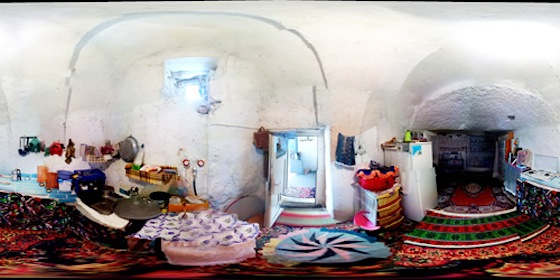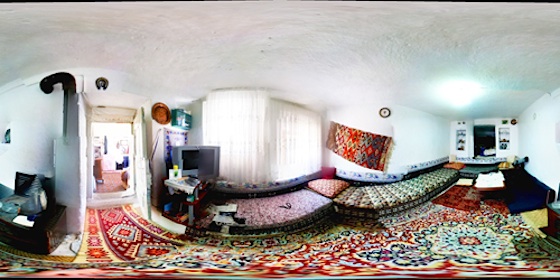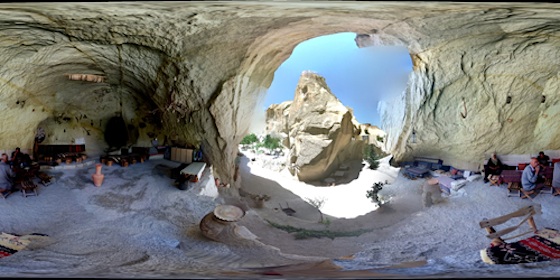 Nothing is more earth-friendly than carving out an existence in the belly of a cave. Yet, despite its 1985 UNESCO cultural and natural World Heritage Site listing, development and mass tourism often overrun traditional life in the surreal fairy-chimney-pocked landscape of Turkey’s Göreme-Cappadocia, rendering genuine cave dwellers a near-extinct species.
Nothing is more earth-friendly than carving out an existence in the belly of a cave. Yet, despite its 1985 UNESCO cultural and natural World Heritage Site listing, development and mass tourism often overrun traditional life in the surreal fairy-chimney-pocked landscape of Turkey’s Göreme-Cappadocia, rendering genuine cave dwellers a near-extinct species.
Gripped by a longstanding love affair with the region, visual artist Aili Schmeltz spent last summer in the Ibrahimpasa village documenting the homes of more than a dozen cave dwellers. She collected hours of audio footage and thousands of images, four of which she has shared with us. Within the next year, she hopes to arrange her work in a book that will help save this priceless heritage.
“My fascination with Cappadocia began as a freshman in college when I stumbled upon a book about vernacular architecture entitled Prodigious Buildersby Bernard Rudofsky,” Schmeltz told us in an email interview. “The book introduced me to the cave dwellings of Cappadocia that have captivated and mesmerized me ever since,” she adds.
Despite its harsh environment, the Cappadocia cave dwellers have been eking out a modest living for millennia.
“The area is most famous for its occupation of Christian settlers who fled to the area to escape persecution from the Romans,” according to Schmeizt. The occupants were entirely self-sufficient and developed an intricate network of living and storage spaces with protective, sealed entrances.
After raising funds through the Kickstarter crowd-funding platform, Schmeltz eventually managed to visit 13 personal dwellings, 20 historical cave sites (including a vast underground city) and a series of recently-modernized spaces that have never been inhabited.

“The project would not have been possible without the help of Mehmet Bozlak, a native of the area who runs Bozlak Travel in Göreme,” says Schmeltz.” He served as translator, friend, tour guide, historian and bridge into a culture and people inaccessible to a Western woman such as myself.”
While the project essentially went as planned and the LA-based artist was able to collect more footage than she needed for the next phase of the Lives in Cappadocia project, she says that she came away with so much more than she could have hoped – largely thanks to the spirit of the local people.
“The interiors of the homes were very colorful, many covered in layers of beautiful rugs and tapestries, not at all what I imagined a cave dwelling to look like inside.T he stories that were told about the histories of the homes too were very interesting, many of family histories and local legends, the history of the area was and continues to be complex.. if only those rocks could talk!”
In addition to satiating her own curiosity, Schmeltz hopes that her upcoming book, prints, drawings, writings and digital collages will contribute to a greater preservation initiative she says is needed to preserve a fading cultural and social heritage.
“I feel strongly that this project has lasting importance and contribution to not only the field of art, but also to wide stretching studies of culture, history, and sociology. The cave dwellers of Cappadocia are rapidly disappearing, while the tourism industry is expanding at a rapid pace, displacing families that have lived in these caves for hundreds of years,” she writes.
The World Heritage Site website claims that “although the area has been extensively used and modified by man for centuries the resulting landscape is one of harmony and consideration of the intrinsic values of the natural landforms.” But development has challenged this tradition – a theme that is at the very crux of her creative exploration during Schmeltz’s enlightened sojourn.
“This project is unique to these people and place, this hasn’t been done before,” writes the artist. “It will resonate as both an art piece and a document of a time that is quickly passing.”
all images via Aili Schmeltz
More on Caves and Cappadocia:
The Epitome of Sustainable Architecture: 700 Year Old Iranian Cave Homes
Selçuklu Evi Ecoish Boutique Hotel in Turkey
Stay Cool in Turkey’s 5 Star Underground Yunak Evleri Hotel






I would live in a place like this. Though I think I’d have to buy the land where the cave is so it will truly be my home. Not only is it more cost friendly but it can be a way to express my creativity through designing the interior.